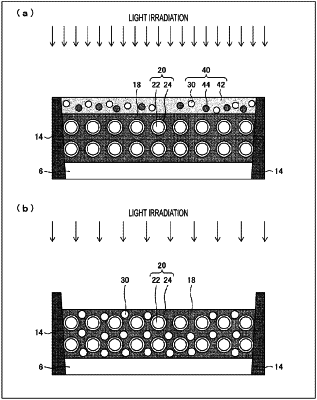| CPC H01L 33/504 (2013.01) [H01L 33/005 (2013.01); H01L 33/405 (2013.01); H01L 2933/0016 (2013.01); H01L 2933/0041 (2013.01)] | 39 Claims |

|
1. A method for manufacturing a light-emitting device provided with a light-emitting element on a substrate, the light-emitting element including a first electrode, a second electrode, and a quantum dot layer interposed between the first electrode and the second electrode, the method comprising:
forming the quantum dot layer,
the forming the quantum dot layer including
performing first application that involves applying a first solution containing a first solvent, a plurality of quantum dots, and a ligand to coordinate with each of the plurality of quantum dots on a position overlapping with the substrate,
performing first heating, subsequent to the performing first application, that involves raising an atmospheric temperature around the substrate to a temperature equal to or higher than a first temperature,
performing cooling, subsequent to the performing first heating, that involves lowering the atmospheric temperature to a temperature equal to or lower than the lower temperature of a melting point of the ligand and a boiling point of the first solvent,
performing second application, subsequent to the performing cooling, that involves applying a second solution containing a second solvent and a first inorganic precursor on a position overlapping with the substrate, and
performing second heating, subsequent to the performing second application, that involves raising the atmospheric temperature to a second temperature,
wherein the quantum dot includes a core and a first shell with which the core is coated,
the first temperature is the higher temperature of the melting point of the ligand and the boiling point of the first solvent,
the second temperature is a temperature which is higher than the first temperature, and at which the first inorganic precursor epitaxially grows around the first shell to form a second shell with which the first shell is coated, and
at least one set of the quantum dots adjacent to each other is connected to each other via the second shell in the performing second heating.
|
|
6. A method for manufacturing a light-emitting device provided with a light-emitting element on a substrate, the light-emitting element including a first electrode, a second electrode, and a quantum dot layer interposed between the first electrode and the second electrode, the method comprising:
forming the quantum dot layer,
the forming the quantum dot layer including
performing first application that involves applying a first solution containing a plurality of quantum dots each including a core and a first shell with which the core is coated, a ligand to coordinate with each of the plurality of quantum dots, and a first solvent on a position overlapping with the substrate,
performing first light irradiation, subsequent to the performing first application, that involves irradiating with light, from above the substrate, the position where the first solution is applied, to melt the ligand and vaporize the first solvent,
cooling the quantum dot, subsequent to the performing first light irradiation, to a temperature equal to or lower than the lower temperature of a melting point of the ligand and a boiling point of the first solvent,
performing second application, subsequent to the cooling the quantum dot, that involves applying a second solution containing a second solvent and a first inorganic precursor on a position overlapping with the substrate,
performing second light irradiation, subsequent to the performing second application, that involves irradiating the position with light to raise the temperature of the quantum dot, and
performing third light irradiation, subsequent to the performing second light irradiation, that involves irradiating the position with light to cause the first inorganic precursor to epitaxially grow around the first shell so as to form a second shell with which the first shell is coated,
wherein, in the performing third light irradiation, at least one set of the quantum dots adjacent to each other is connected to each other via the second shell.
|